

Quechua Language and the Quechua (Inca) Indians (Quichua, Inga, Runasimi) The Lost Inca Empire. By Liesl Clark Posted 11.01.00 NOVA "Land of the Four Quarters" or Tahuantinsuyu is the name the Inca gave to their empire.
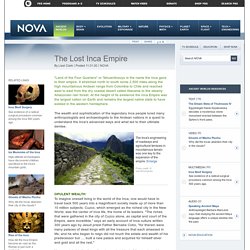
It stretched north to south some 2,500 miles along the high mountainous Andean range from Colombia to Chile and reached west to east from the dry coastal desert called Atacama to the steamy Amazonian rain forest. Aztec, Maya & Inca foods. Inca religion. Beginner's Guide to the Inca Empire. Viracocha And The Coming Of The Incas. Sacred Texts Native American Index Previous Next from "History of the Incas" by Pedro Sarmiento De Gamboa, translated by Clements Markham, Cambridge: The Hakluyt Society 1907, pp. 28-58.
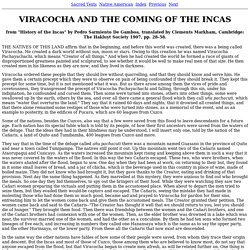
THE NATIVES OF THIS LAND affirm that in the beginning, and before this world was created, there was a being called Viracocha. He created a dark world without sun, moon or stars. Owing to this creation he was named Viracocha Pachayachachi, which means "Creator of all things. " And when he had created the world he formed a race of giants of disproportioned greatness painted and sculptured, to see whether it would be well to make real men of that size. Viracocha ordered these people that they should live without quarrelling, and that they should know and serve him.
Some of the nations, besides the Cuzcos, also say that a few were saved from this flood to leave descendants for a future age. IT IS RELATED that everything was destroyed in the flood called uñu pachacuti. His orders were obeyed during the war. Incas - HowStuffWorks. Inca Facts, information, pictures. Inca (Ĭng´kə), pre-Columbian empire, W South America.
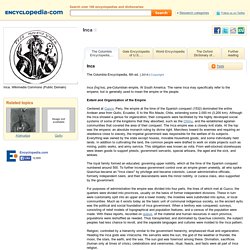
The Incas. The Incas The Incas, an American Indian people, were originally a small tribe in the southern highlands of Peru.
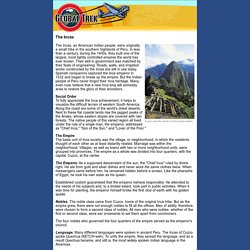
In less than a century, during the 1400s, they built one of the largest, most tightly controlled empires the world has ever known. Their skill in government was matched by their feats of engineering. Prehistoric Inca neurosurgery – Neurophilosophy. The procedure known as trepanation, in which a hole is scraped or drilled in the skull, is an ancient form of neurosurgery that has been performed since the late Stone Age.

Exactly why ancient peoples performed trepanation has remained a matter of debate: some researchers argue that it was performed for medical reasons, as it is today, while others believe it was done for magical or religious reasons. A new study by two American anthropologists now provides evidence that the Incas performed trepanation to treat head injuries; that the procedure was far more common than was previously thought; and that the Incan practitioners of trepanation were highly skilled surgeons with a detailed knowledge of the anatomy of the skull. Of these 411 skulls, 66 exhibited perforations of varying shape and size. More than half were circular, but some were oval or irregularly circular, and one (above) was rectangular. The diameters of the circular holes ranged from approximately 0.3 – 7.3 cm. HISTORY OF THE INCAS. The Conquest of Peru and the Inca Empire. Exploring the Inca Heartland: Machu Picchu.
We wandered down a long stretch of Inca road from the Sun Gate, enjoying the view of the site below us and feeling good about having hiked the Inca Trail.
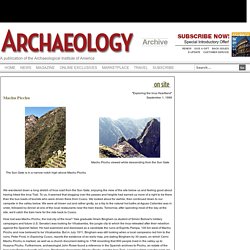
To us, it seemed that slogging over the passes and heights had earned us more of a right to be there than the bus loads of tourists who were driven there from Cusco. We looked about for awhile, then continued down to our campsite in the valley below. Inca mathematics. Version for printing It is often thought that mathematics can only develop after a civilisation has developed some form of writing.

Although not easy for us to understand today, many civilisations reached highly advanced states without ever developing written records. Now of course it is difficult for us to know much about such civilisations since there is no written record to be studied today. This article looks at the mathematical achievements of one such civilisation. Inca Skull Surgeons Were "Highly Skilled," Study Finds. May 12, 2008 Inca surgeons in ancient Peru commonly and successfully removed small portions of patients' skulls to treat head injuries, according to a new study.

The surgical procedure—known as trepanation—was most often performed on adult men, likely to treat injuries suffered during combat, researchers say. A similar procedure is performed today to relieve pressure caused by fluid buildup following severe head trauma. Around the ancient Inca capital of Cuzco (see Peru map), remains dating back to A.D. 1000 show that surgical techniques were standardized and perfected over time, according to the report. National Geographic. Steeped in death, conquest, desire, and mystery, the legend of the lost Inca gold is guarded by remote, mist-veiled mountains in central Ecuador.

Somewhere deep inside the unforgiving Llanganates mountain range between the Andes and the Amazon is said to exist a fabulous Inca hoard hidden from Spanish conquistadors. The legend begins in the 16th century, when the great Inca Empire in western South America was giving way to European invaders. Atahualpa was an Inca king who, after warring with his half-brother, Huáscar, for control of the empire, was captured at his palace in Cajamarca in modern-day Peru by Spanish commander Francisco Pizarro. Pizarro agreed to release Atahualpa in return for a roomful of gold, but the Spaniard later reneged on the deal. Inca Empire Timeline and King List. Timeline and Kinglist of the Inca Empire The Inca word for ruler was 'capac', or 'capa', and the next ruler was chosen both by heredity and by marriage lines.
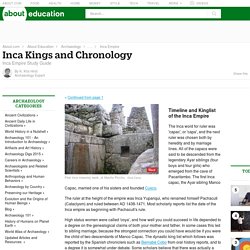
Quipu - Ancient Writing System of the Incas. The Inca writing system called quipu (also spelled khipu or quipo) is the only known precolumbian writing system in South America—well, perhaps writing system isn't quite the correct phrase. But quipus were clearly an information transmittal system, and not just for the Inca. Instead of a clay tablet impressed with triangles like cuneiform, or a piece of paper with symbols written on it like Egyptian hieroglyphs, a quipu is essentially a collection of wool and cotton strings tied together, a knotted page of information which could be easily transported and easily translated across the wide expanses of South America. Inca Architecture at Machu Picchu. Inca Road System Construction and Lodging.
The Inca road system (called Capaq Ñan in Quechua and Gran Ruta Inca in Spanish) was an essential part of the success of the Inca Empire. The road system included an astounding 40,000 kilometers (25,000 miles) of roads, bridges, tunnels and causeways. Road construction began in the mid-fifteenth century when the Inca gained control over its neighbors and started expanding its empire; it ended abruptly 125 years later when the Spanish arrived in Peru.
As a contrast, the Roman Empire built twice as many miles of road, but it took them 600 years. An Overview of Inca Tech. Geography Drives Technology The Incas inherited an unforgiving geographic landscape. Despite its overwhelming beauty, its various terrains held hazards and risks.